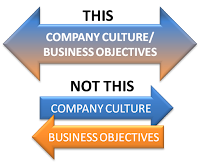A recent article in the Wall Street Journal discussed the topic, describing shades-of-grey people as more ambivalent – more likely to see both sides of an argument and waffle on decision making – than people who see things more concretely as black or white who tend have “unequivocal” views and less ambivalence.
What’s the impact of these two personality types at work?
“One of the most widely studied aspects of ambivalence is how it affects thinking. Because of their strongly positive or strongly negative views, black-and-white thinkers tend to be quicker at making decisions than highly ambivalent people. But if they get mired in one point of view and can't see others, black-and-white thinking may prompt conflict with others or unhealthy thoughts or behaviors.”If you’re a black-and-white manager, that could have profound impact on your people. Research from GreenPeak Partners found:
“In fact, executives who lack interpersonal skills – executives who just focus on numbers and processes and wreak havoc on their people – perform badly over all but the shortest of time periods. And their businesses do as well. This is a verifiable fact. Executives who are bullies – who are arrogant, “too direct,” impatient or stubborn – are poor performers, not only as people managers, but also at developing strategy and delivering bottom-line financial results. (emphasis original)This backs up the Gallup research that found causation, not correlation, between employee engagement and financial performance:
“Executives who are good “people managers” (i.e. possess strong core leadership skills) on the other hand, produce better strategic and financial performance as well. In other words, soft values drive hard results. …
“The study shows that ‘results-at-all-costs’ executives actually diminish the bottom line, especially over time, while self-aware leaders with strong interpersonal skills deliver better financial performance.”
“We find that the path from the individual engagement elements to financial performance is stronger than the path from financial performance to engagement.”And as we say in our new book, Winning with a Culture of Recognition:
"The connection between engagement and higher performance is obvious, and while there are many ways to inspire engagement (and even more to kill it) all involve communicating and rewarding desired behaviors based on defined values.”If you pride yourself on being a black-and-white thinker, you may want to consider adding some shades of grey. Your team and company performance will be better for it.






















